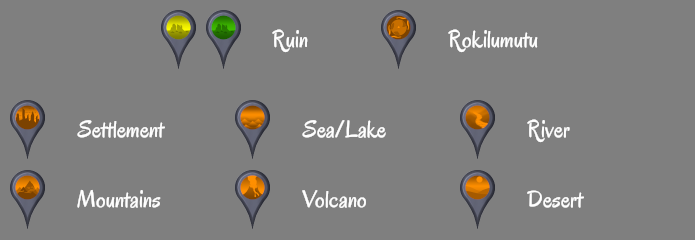Ralenlos Mountains
The central mountain massif on Mustik Hamesi.
Geography
Formation
The two forces responsible for shaping the Ralenlos mountains are Larekon's energy impacting Ranul's surface on one side and Kasavoa's gravity pulling on the other. Consequently, the moon's tectonic plates move towards the center of Mustik Hamesi where they collide and push each other upwards. The mountain massif grows about 3.2 cm per Rilsu year.Defining Features
The name Ralenlos literally means "enormous mountain(s)", referring to the fact that they tower above all other mountains ranges on Ranul. As of 821 VZR, the highest peak lies approximately 4.7 km above sea level. The folds of rock surrounding it stretch for between 200 and 300 km in any direction. They consist mostly of reddish, iron-rich granite and schist.Ecosystem
The mountains are snow-capped above approximately 4.5 km. The rain which falls below this line washes most of the fertile soil down towards the three seas, especially the torrential downpours which occur during the Heat Season. Consequently, there is little vegetation in this area.
Localized Phenomena
The Ralenlos mountains are subject to strong groundquakes due to the collision of multiple plates. These are especially dangerous during the Heat Season when the tectonic forces are at their peak.
Fauna & Flora
Life is concentrated near the foot of the mountains. The flora mainly consists of succulents, lichens and hardy shrubbery. The biggest herbivores in this area are the pungiz beetles , who in turn are the primary food source for the ralukir packs.
Natural Resources
The mountains provide various forms of rock and metal ores.
Cultural Importance
History
During the last year of the Final War, a small part of Ranul's population began moving to shelters up in these mountains. While the groundquakes, summer tempests and overall barren landscape did not make the terrain particularly attractive, it had several advantages.
- It was at a safe distance from the population centers on the sea coasts. This reduced the risk of being targeted by attacks.
- Model calculations predicted that radioactive fallout from weapons of mass destruction would be less likely to travel to these heights. Indeed, most of the fallout did get washed down by the rain before reaching the shelters.
- Since clouds on Ranul tend to move towards the Ralenlos mountains, water was more likely to be found here than in the deserts.
- Compared to the deserts in Hazu Ropuru, it was less affected by Larevok's mutagenic radiation.
- The rock formations were more likely to provide natural protection than the sandy ground in the lower regions.
Tourism
Several of the wartime shelters have been preserved as sites of historical importance. As such, they are frequently visited by researchers or school classes.
The mountains also see a fair amount of hikers and climbers, especially after centuries of technological progress have made such endeavours comparably safe. However, this does not stop thrill seekers from trying to reach the peak with minimal equipment in order to brag about it on social media.






Comments
Author's Notes
It was about time that I fleshed out this stub, especially since the "Nonfi Nis" game will be set in this area. What do you think of it? Does everything make sense? Is there anything else you would like to know?